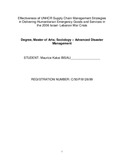| dc.description.abstract | Reaching displaced people in a humanitarian emergency is heavily dependent on the effectiveness of a Supply Chain, its structure and management systems. An effective disaster response Supply Chain in humanitarian entity is modeled into three stages: preparedness, response, and recovery (Carter, 1999). During the response phase three key factors of rapidity, flexibility and adaptability must also exist. International humanitarian emergency operations are complex in nature, connecting several different sectors, actors, and varying activities. UNHCR is expected to have a capacity to respond to a new emergency of up to 500,000 people at any given moment within 72 hours from the time an emergency occurs, but the first delivery in Lebanon arrived six days after the emergency was declared. The supply delivery strategy adopted by UNHCR in Lebanon was based on standard and routine practices rather than the unique circumstances in which the operations were conducted.
Lebanon was the study site based on the new and unique mandate of UNHCR in providing assistance to internally displaced persons (lOP's) which was different from its traditional role of protecting and assisting refugees. The site therefore provided an opportunity to assess how UNHCR managed this new and challenging responsibility, in a war zone, highly politicized operational environment and crowded with other humanitarian agencies. The unit of analysis in this study was the supply chain strategies that UNHCR adopted in the 2006 crisis. Existing Staffing systems and structures, Relief goods Stockpiling location and transport infrastructure, actual Supply Chain Performance assessment during the crises including Operational environment and interagency Co-ordination were the units observed.
Different combinations of techniques and tools used to collect data included; interviews using a questionnaire and an interview schedule, unstructured interviews and forums, purposive sampling technique, direct observations and desk reviews of published and unpublished literature. The UNHCR Lebanon emergency was therefore not effective and efficient. The correct goods, in the right quantity and the right quality, did not reach the targeted population at the right time and right place. The general conclusion and recommendation drawn from the study is that donors social political approaches to funding, drives competition among humanitarian organizations, thus causing egocentric and competitive behaviors. Donor behaviors and funding patterns affects humanitarian Supply Chain entities strategies. With goodwill, donors can change the current egocentric behavior by agencies to social centric which will improve the humanitarian supply chain service delivery to beneficiaries. Proactive and need based donations rather than reactive and politicized will improve future Supply Chain emergency preparedness and response among humanitarian agencies. | en_US |

